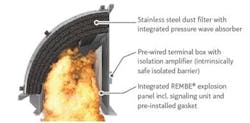Jeramy Slaunwhite, Chief Technical Officer, REMBE® Inc.
The effects of a dust explosion can be devastating for people, property and processes. When combustible particulate material is handled or produced, the associated fire and explosion hazards must be addressed, and the risks managed, to prevent catastrophic or fatal consequences.
Among the various methods to protect against a dust explosion, relief venting is the simplest and most common. Explosion venting is a passive explosion protection method consisting of a designed weak point in the protected enclosure, typically a door or panel which quickly opens at a predefined pressure well below the strength limit of the enclosure. Venting allows the internal pressure and fireball to exit the vessel before exceeding the enclosure failure strength. Explosion vents are sized and selected based on established calculations according to standards such as National Fire Protection Association (NFPA) 68 – Standard on Explosion Protection by Deflagration Venting.
Explosion venting is a reliable method of protection for exterior vessels with a safe area to allow the pressure and fireball to safely discharge. However, a vented fireball can extend dozens of feet from the opening with impinging pressures capable of structural damage to nearby people and objects. To manage this hazard, flameless venting was invented by REMBE® in the 1980’s as a safe venting solution for vessels located inside facilities or in outside areas where conventional venting is not safe.
Flameless venting is a two-part explosion venting system consisting of an explosion vent rupture panel and a flame arrestor. The rupture panel is a conventional explosion vent panel; the flame arrestor is a matrix of stainless-steel mesh that allows the vented fireball and gasses to pass through to the exterior but not before removing the flame. This flame quenching is accomplished through thermodynamic heat transfer principals from the burning fireball to the layered network of stainless-steel mesh. The high surface area, thermal conductivity and torturous path of the mesh rapidly absorbs the fireball heat energy below the flash point, quenching the flame and allowing only gasses to exhaust. The gas exhaust temperature and pressure is effectively reduced below human injury intensity within 1m of the external mesh surface. The mesh also serves as a retention barrier for unburnt dust expelled from the vented vessel which would otherwise continue to fuel a propagating fireball. The surrounding area must be a priority in the facility dust accumulation housekeeping plan to avoid a secondary dust cloud from disturbed settled dust.
REMBE® Q-Box® Flameless Vent Functional Illustration
Flameless vents are tested and certified by a credible, third-party organization in accordance with a test standard under various specific parameters including the combustible dust material, concentration, test vessel geometry, pressures and device size. Typically, these are the upper limits for which the device can be applied, i.e. maximum fuel explosion severity (KSt), and protected volume. Evolving technology and knowledge of explosion dynamics has inspired new flameless venting development from REMBE® with broadened flexibility. Most explosion protection applications are pushing the tested limits of the flameless venting device; occasionally one certified limitation influences the sizing and section of the device, typically the effective vent area, KSt or the protected volume. The new Q-Box®R3leaf flameless venting from REMBE® allows for flexible dynamic sizing and selection with performance parameter trade-offs. Lower KSt applications can tolerate a larger protected volume and conversely, smaller volumes can accommodate higher KSt applications than the conventional maximum limit approach. This sliding limit scale of the Q-Box®R3leaf provides maximum application flexibility and an optimized right-size approach to flameless venting. Additionally, the Q-Box®R3leaf was designed with sustainability in mind. The all-stainless steel, weldless design provides not only improved venting application efficiency but a reduced environmental carbon footprint compared to manufacturing and logistics of the conventional Q-Box® flameless vent.
Flameless vents are available in different design geometries with varying performance parameters, application compatibility, efficiencies, and costs. For example, the temperature of a wood dust deflagration flame is significantly lower than an aluminum dust fueled deflagration. A high temperature aluminum deflagration could overwhelm the capacity of a flame arrestor designed for organic dusts resulting in flame discharge or catastrophic failure of the protection device. Performance approval tests carried out also consider fuel-based performance factors that could cause blockage of the flame arresting media such as melting or fibrous dusts. Approved use of flameless venting devices with these material types as well as metal dusts must be specifically identified in the testing certification and equipment labeling to ensure effective protection.
It is important to note that a complete explosion protection strategy must also include isolation to prevent an explosion from propagating to other interconnected equipment and areas.
Flameless venting is very advantageous in the manufacturing industry for processes producing and handing fine, dry combustible dust, powders and particulate solids. Typical process equipment with explosion hazards often located inside plants include covered conveyers, dryer systems, hammer mills, storage bins, silos, elevators, sifters, cyclones and baghouses. Even equipment located outside can benefit from flameless venting with certified weather covers to manage otherwise challenging explosion vent discharge bast zones.
Combustible dust explosion hazards can be challenging to manage. The discharge effects of open explosion relief venting require significant amounts of controlled space for personnel safety. When designed and applied appropriately according to the testing and certification parameters, flameless venting can be an efficient and valuable tool to optimize operational space while elevating the safety, reliability and ease of maintenance of explosion protection solutions.
SUMMARY
REMBE® developed the first flameless dust explosion venting system in the 1980’s, based on the principal in which the flames are cooled extremely efficiently within the mesh filter of the flame absorber and extinguished immediately. The typical fireball and pressure wave discharge during explosion venting are reduced to harmless levels, allowing for a safe protected installation inside the production facility with virtually no maintenance or complex controls. Flameless venting is performance certified by third-party testing to guarantee protection for people, property and processes. Technology advancements have continued to evolve and optimize flameless venting capabilities with proven designs for organic & metal dusts, flexible application compatibility and environmentally conscientious construction. The REMBE® Q-Box® provides cost effective flameless explosion protection for most organic dust applications. The REMBE® Q-Rohr®, the all-rounder, is certified for all dust types including metals and is approved by FM Global. The REMBE® Q-Ball® is low weight flameless venting specifically designed for bucket elevators and sifter screens. The new REMBE® Q-Box® R3leaf™ offers optimized application flexibility with a low carbon footprint design.
The REMBE® team of explosion safety experts are at your service to evaluate and protect against dust explosions with reliable, certified solutions for peace-of mind protection of people, property and processes. Safety is for Life™.


